Monzo’s fintech marketing genius ✨ (and what we can learn from it)
Marketing that doesn't feel like marketing
Welcome to Payments Culture!
This newsletter explores how money moves, around the world.
This week: my experience at Monzo’s book pop-up, and what it tells us about fintech marketing.
I’m currently looking for new opportunities in fintech and payments, such as consulting, writing, and advising. Email me or contact me on LinkedIn for a conversation.
In prestigious MBA courses around the world, one of the key things you learn is that giving away free chocolate is the best way to ensure customer loyalty.
Actually, I made that up… BUT Most fintech marketing is boring, and Monzo has a particular marketing nous that was unheard of in banking. Monzo’s marketing genius deserves further exploration, not just because of how revolutionary it was, and still is, but because of something fun that happened in the past days.
Until Monzo, banking was so serious
Prior to Monzo, banks in the UK were serious. Of course, this does make sense. Money is a serious business, and keeping your money safe is just about the most important thing a bank can do. There was a certain reputation that banks have sought to develop and maintain. For decades, or even centuries, banks had consciously leaned on the side of seriousness over playfulness.
HSBC “The world’s local bank” (emphasising their global reach)
Lloyds Bank “By your side”
And a US example, Bank of America “Higher standards” (corporate and emphasising reliability)
The clearest example of this reliance on heritage is Barclays.
In 2015, when Monzo was first emerging, Barclays celebrated their 325th anniversary. This makes Barclays older than the Bank of England, and also the United States of America itself! Heritage and trust go hand-in-hand, and if a bank survived two World Wars and everything else since, then they’ll surely be a safe place to keep your money.
But banks got complacent. Monzo and their fellow cohort of neobanks that emerged in the mid-2010s flipped the script. There was a new style emerging and the old style banks were missing a trick. The neobanks lacked the deep pockets and marketing budgets of the big banks, so they had to be innovative.
Building the Monzo community
Monzo has always had a playfulness, a conversational tone, and something which often goes unremarked upon: a sense of community, even from day one. Until this point in time, the idea of a bank developing an online community seemed frivolous. This wasn’t needed in a world of banks with branches, but for a neobank operating via a mobile app, the sense of online community was essential.
The community build started from day one. During the early days of Monzo there was a waiting list. The company didn’t hide the fact that its earliest users were testers as well as users. People could jump the queue by getting a “golden ticket” from an existing user. At times, these golden tickets were hard to come by.
This golden ticket showed in-app to existing users, and the whole process made referring a friend feel fun. The Charlie and the Chocolate Factory reference was clear. It was the beginning of making banking exciting. Financial services had long been stuffy and stale, but Monzo would change that.
Monzo originally started as Mondo. But in 2016, due to a legal dispute, the bank was forced to change their name. Suggestions were sourced from the user community. Users were asked for suggestions beginning with M. Over 12,000 suggestions were submitted by early users and Monzo won the day.
This community involvement has continued ever since.
Monzo is the only UK bank that has a community forum where users can read the latest product news, post comments, and even interact with members of staff directly. Starling Bank and Revolut previously had community forums but they closed them some years back. No public rationale was given for the closure, yet most speculation suggests that these banks didn’t want to put the effort into moderating their communities. Monzo didn’t see their community as a burden — they saw it as a powerful tool for building engagement.
Monzo’s forum is less active today than it once was, and in reality, in the early years, the community was listened to a bit too much.
I joined Monzo in 2017, but it wasn’t until 2019 that I felt like more than a customer.
Back then, they tried — and failed — to launch Plus accounts, a set of packaged accounts with monthly fees. The first iteration flopped and the feedback from the user community was negative. Rather than giving up, Monzo invited users to their office for a feedback session. I was fortunate enough to secure a spot. Around 100 or so users attended and for a couple of hours, we were treated to presentations and Q&A sessions with product managers and senior leaders. There was delicious free food and drink, and I got a goody bag with a Monzo t-shirt.
I walked away thinking “I can’t believe a bank treats its customers like this!”
I was a fan for life, and have used Monzo as my main bank account since then. But in a world where every marketing dollar has to be justified, holding customer events like the one I attended in 2019 are hard to get signed off. Post-pandemic the community events dried up or were done online in smaller focus groups.
The reality is that since TS Anil became the Monzo CEO, the focus has shifted more to profitability over community, yet the past week shows that the community aspect of Monzo is alive and kicking.
Getting the book of money
Last week, Monzo held a two-day pop-up in Soho, central London, which served as a book launch. Monzo’s the book of money came out on Thursday, 4th September.
I can’t call it a pop-up store as there was nothing to buy. Instead, those who waited patiently and got to the front of the queue were welcomed into the venue by Monzo staff. Once inside, customers could get a free customised copy of the book of money.
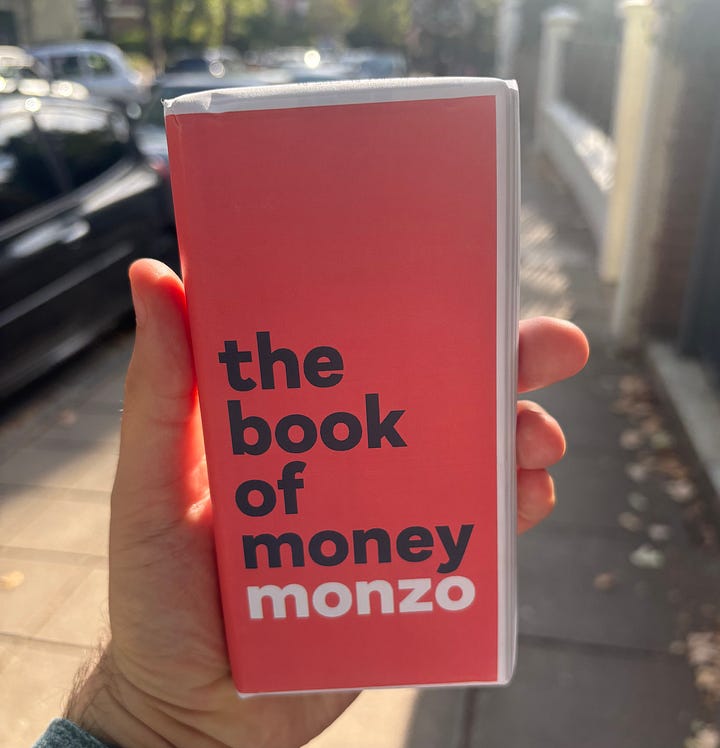
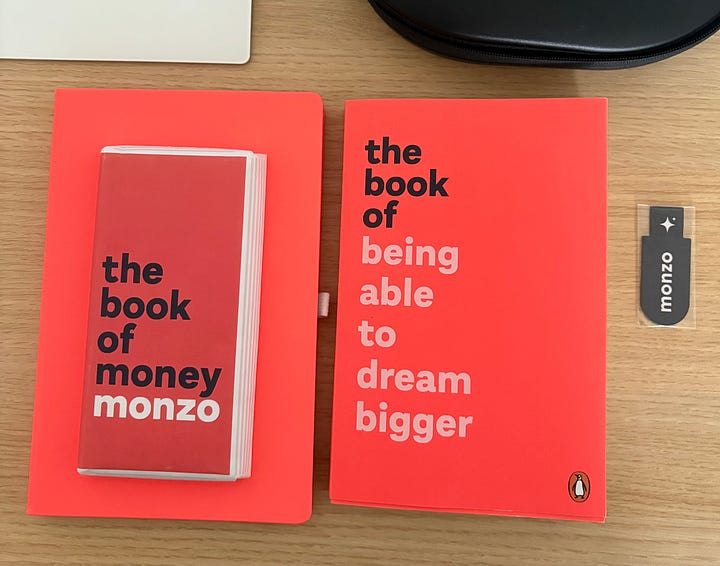
Here’s how it worked:
Three money-related questions on a touchscreen generated a personalised title from 800 possibilities.
After browsing through different options, I selected the one I liked and waited a few minutes for printing.
Along with the book, I got a tote bag with a bookmark, a notebook, and a Monzo themed bar of chocolate (which was Tony’s Chocolonely on the inside).
In a nod to Monzo’s earlier days, some customers got a golden ticket inside their customised book, which contained a gift voucher for a UK-based bookstore chain.
I had only found out about the pop-up from Monzo’s Instagram account earlier in the week, but I’m glad I went along. The event captured some of the magic of Monzo’s early years and shows that, despite the focus on revenue and profit in recent years, the community marketing ethos is alive and well.
The genius of Monzo’s fintech marketing is that it’s never felt like marketing at all.
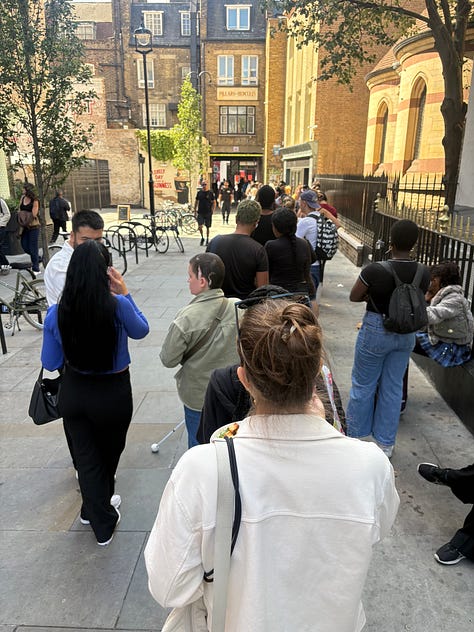
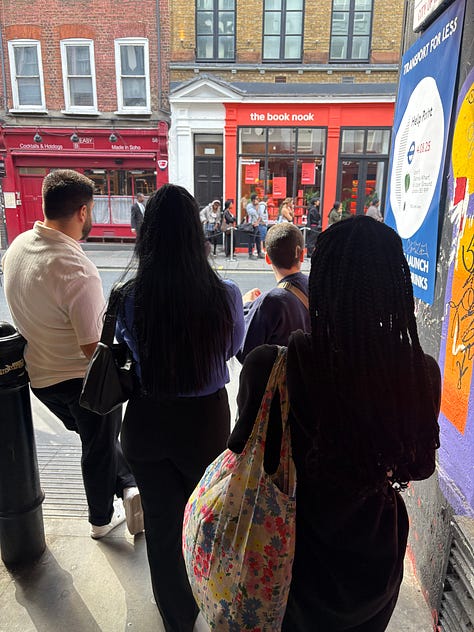
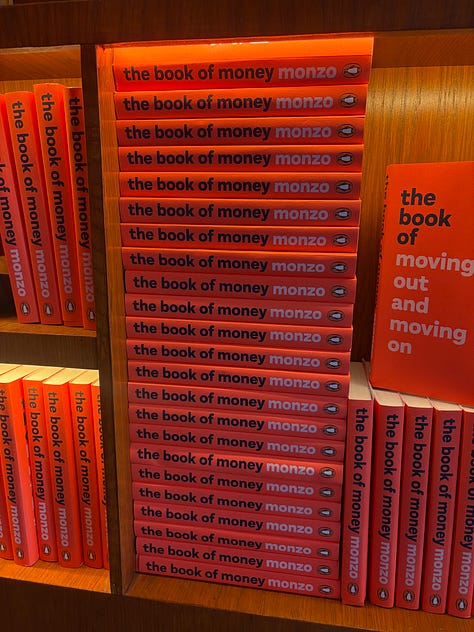
They’ve not followed the traditional playbook of SEO-optimised content and TV ads, instead they’ve grown primarily through word of mouth and a social media presence that’s conversational rather than salesy.
While Monzo’s marketing strategy would struggle to get approved by most banks, and indeed most other fintechs, it’s been an undoubted success. The bank has over 13 million customers in the UK — which is 1 in 4 UK adults — and while only a few thousand lined up to get their free book and chocolate bar last week, countless more saw and shared the campaign on social media.
To end this post here’s the first paragraph of the foreword to the book of money, by Monzo CEO, TS Anil:
This is a book about money. Not the history of money, or money as some abstract concept, but money as it exists in your life. How you spend it, what it means you can do in the future and, most importantly, how it makes you feel.
That’s exactly what’s been in Monzo’s DNA since the start, and that traditional banks broadly still don’t get. How people feel about money, and feel about banking in the 2020s is more than interest rates and fees. Feeling part of something is just as important. This should be a key part of any MBA. Community and connection as much as metrics and models.
Thanks for reading Payments Culture!
Please leave a comment or share with a friend if you enjoyed reading this edition. It’s much appreciated and helps grow the audience of this newsletter.
Note that views expressed on this Substack are my own and do not represent any other organisation. Also nothing I say should be taken as investment advice.



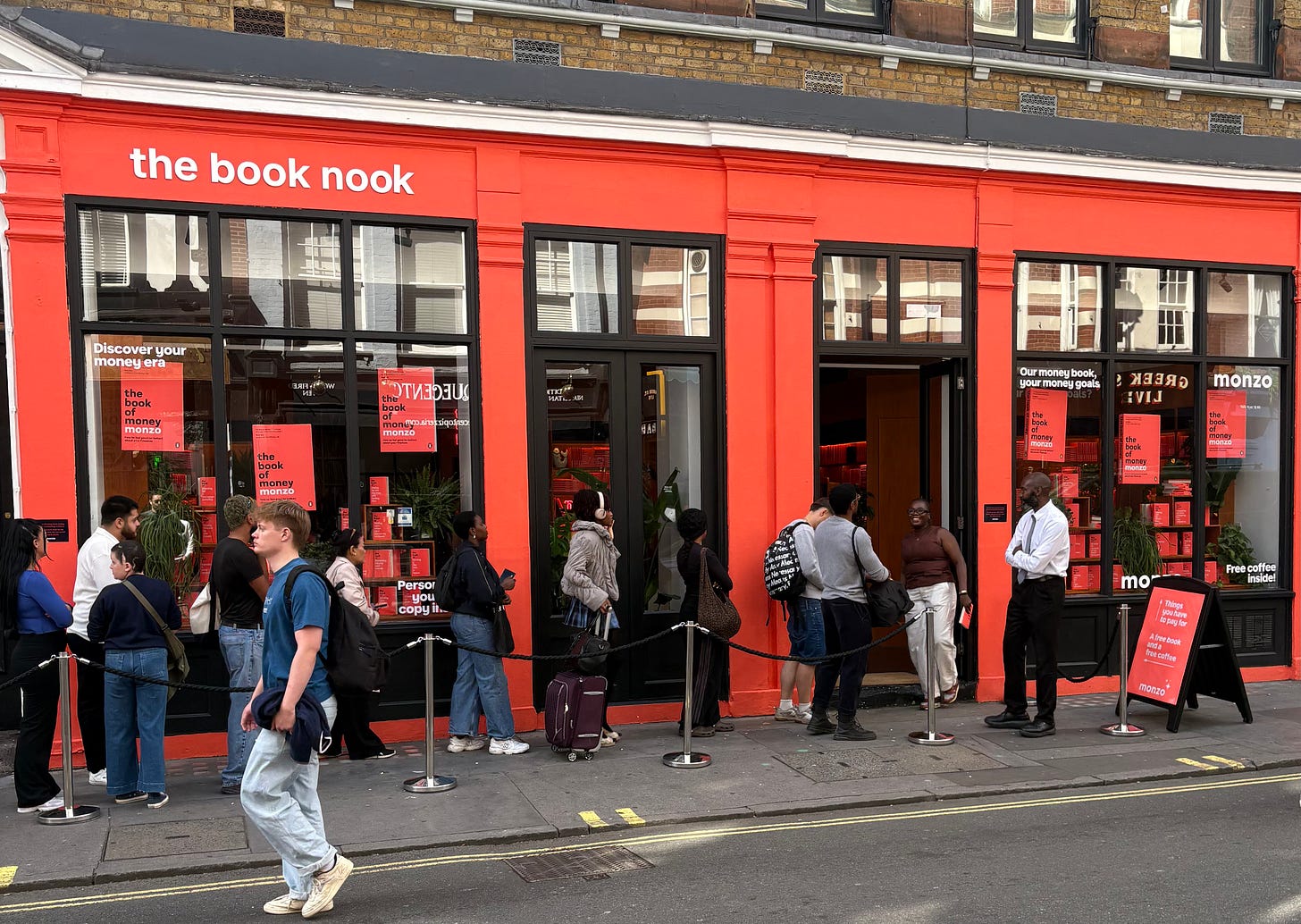
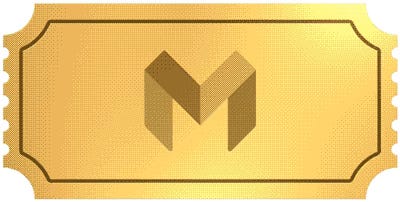
Really enjoyed this deep dive into Monzo’s approach — the focus on community and making banking feel personal is inspiring. It’s interesting to see how fintechs are blending engagement with strategy to create loyalty beyond traditional metrics. TCLM often covers similar topics around payments and fintech trends, which can be a helpful lens for anyone following these shifts.
(It’s free)- https://tradecredit.substack.com/subscribe
An enjoyable read, especially for a fintech nerd like myself. Thanks Matt. Monzo was definitely a refreshing divergence from the banking scene. It kicked up a dust and invited the world to look at this serious world with some fun goggles. Certainly changed how we thought about banking engagement, retention, and certainly, UX.